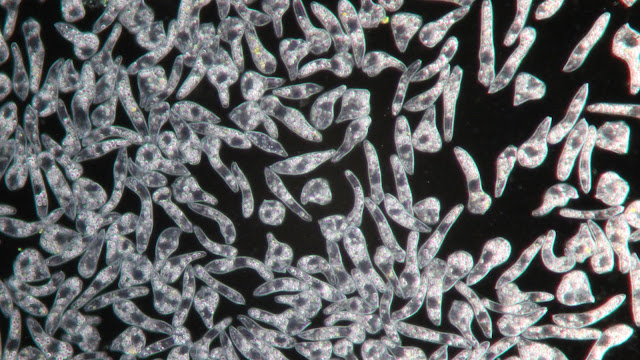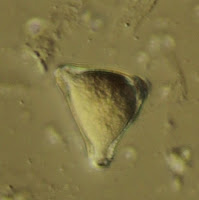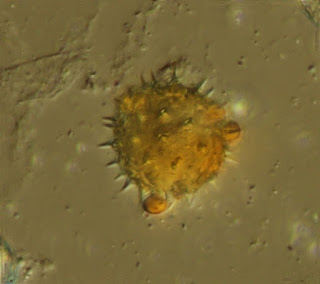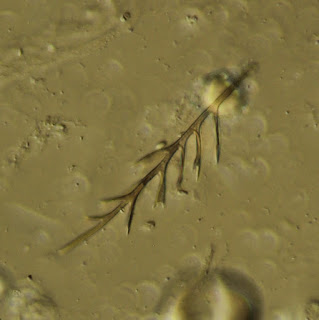In my last water sample from the La Salle river I was lucky enough to capture a number of Stentor coeruleus. These large bluish-purple Stentors can be spectacular when observed under a stereoscope with a higher power but the detail doesn't show up till you get them under a coverslip. With careful observation you can see the moniliform macronucleus, the oral ciliature and membranelles, cortical rows and the contractile vacuole.
An informal presentation of my journey from wide-eyed neophyte to owner of an affordable research microscope and all the bumps, bruises, pitfalls and yes, enlightenment, along the way. My perspective is that of a hobbyist and my goal is a layman's familiarity with the alien life of a water droplet.
Tuesday 30 April 2024
Sunday 28 April 2024
New water samples after a long winter...
 |
| Possibly Genus Pandorina |
 | |||||||||||||||||||||||||
| Synura |
 |
| Phacus |
Ciliate division, possibly from the genus Stylonychia
I have witnessed this a number of time but have always lost the couple at the end when they seem to zoom off very quickly just as they divide. This time I seem to have caught them in the act of separating.
Tuesday 23 April 2024
Isolating and selecting microscope specimens
Deliberately selecting specimens to view under a microscope has always been a challenge for me...but I'm getting better! I thought I'd share my methodology in the hope that someone else can benefit from my experience. But before I get to the basics of what I do it's important to share that reading about techniques will only get you so far, you have to practice to get better. In my experience, the more you practice, the better you get.
There are two methods I employ, one involves a stereoscope, the other a microscope. My favorite method employs the stereoscope, an LED goose neck lamp and a watch glass. I add 5 to 6 ml of water to my watch glass, apply some side lighting with the LED lamp and start hunting for specimens. My zoom stereoscope can employ powers ranging from 7X to 180X by using various accessory lenses but I generally work in the 14X to 90X range to isolate specimens. First, using a higher power I dial in to a critter that I want to examine with the microscope. possibly clean away debris with a needle, and suck up the specimen using a micro-pipette (20 to 40 ul) with a rubber bulb. This is then transferred to another area of the watch glass and viewed to confirm a successful transfer. If unsuccessful, repeat. When you have the specimen in a water drop, transfer it to a slide, put on a cover slip and start viewing under the microscope.
For those that don't own a stereoscope a similar technique can be employed using your microscope. In this case, a small volume of water, perhaps a couple of ml, is picked up with a dropper or micro-pipette and ejected along the length of a slide. Your specimen is then searched for under a low power, say 4X or 5X, and once found treated just like the critter in the previous paragraph.
Bonus tips: Cover slips float and specimens like to attach themselves to the bottom of them. I use the illustrated tweezers to drop them and pick them up.
And stereoscopes can be as much fun to view protists as microscopes are. 3D and really fun to watch once you become familiar with what you're looking at.
Sunday 21 April 2024
Euglenids exibiting metaboly and flagellum motility
 |
| Euglena |
One of the jars I had been sampling from all winter became
quite green. I took a fairly large sample from the mid jar water and
included some bottom sediment and ran it through the centrifuge at 800
RPM for about ten minutes. Out of the resulting pellet came a
significant number of algae, a large number of which were various
species of euglenids.
 |
| Phacus |
There are now reports of over 1500 species so identification for the layperson is almost impossible.
Monday 8 April 2024
Pass the Pollen, Honey




I also tried stacking a couple of the images with Picolay.

And here is the insect part, ostensibly from a bee. The piece is about 1/10 mm long.
Spring, old specimen jars and new opportunities.
After a long winter of limited access to fresh specimens, my river is again open, at least near the banks. However, the winter was an enlightening season since it taught me much about protist cultures, how to maintain them and how to sample them.
It all started last fall when I filled a standard “fish bowl” with water, mud and a few plants taken from the small river I live on. I began with a relatively large collection of microscopic specimens, including some larger types like gammarus, copepods, ostracods, fairy shrimp and daphnia. The bowl was placed in an east facing windowsill where it received direct morning light. This little micro environment provided a large number of critters for observation but after some time the plants died and things slowed down. Luckily I had a 30 gallon tank that had gone wild and in cleaning it up I was able to add a large matt of algae to my bowl, again rejuvenating it.
 |
| The fish bowl on the extreme left was the container that started it all |
It was at that point I started a jar collection, seeding them with soil, water and algae from the fish bowl. These jars were “fed” with dried oak leaves, dead grasses from under the snow, vegetable scraps and various grains, cereals or even garden dirt. Most of these jars developed in different ways and provided a source of interesting, but limited, species over the winter. Another jar collection was started in a north facing window with none getting direct light. I had noticed the jars on the sunny sill were getting quite warm on clear days.
 |
| My north facing jars |
One jar in which I was doing a Walstad experiment developed an algae explosion that I used to feed several of the jars with larger inhabitants. What I found interesting was that some of my best microbe sources were the smallest containers I used, old 35 mm film containers. I even had a population explosion of several ciliate species under a cover slip on a slide I was keeping in a “wet” container to watch the development of snail eggs.
After providing a winter of enjoyment under the microscope the jars will soon be emptied back into the river, cleaned up and readied for some new, springtime populations.



















